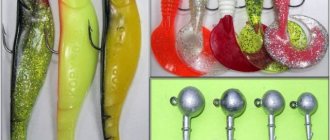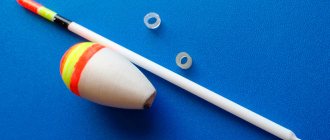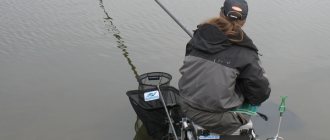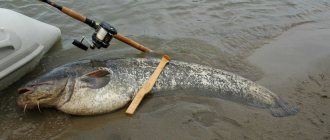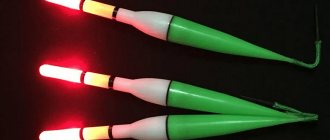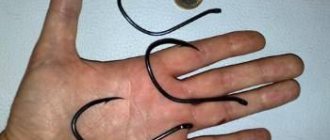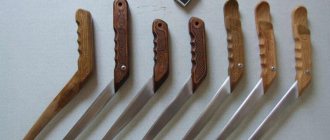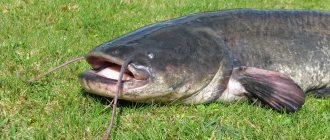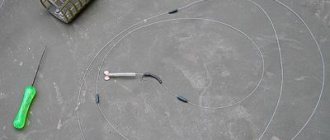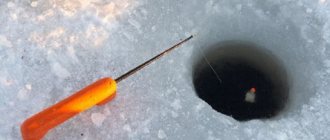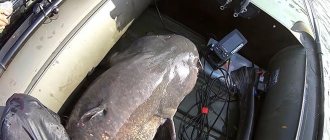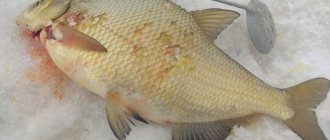Catfish is always a desirable trophy for a fisherman. After all, large specimens can reach 30 kg or more. And defeating such a predator requires dexterity and skill. Various methods of catching are used - hooks, spinning rods, donkeys. The latter is considered the most effective.
Therefore, in this article we will look at the features of catching catfish with an underwater float using bottom tackle, how to make such a device yourself and use it in practice.
What parts does the structure consist of?
The main distinguishing element is the underwater float. In this case, it does not display the bite, as is customary, but provides the necessary mobility of live bait or live bait in the current.
Thus, it becomes much more interesting for the chosen object of fishing - catfish. Comes in the form:
- cylinder;
- elongated ellipse.
The latter is considered universal because it is excellent for fishing both on the river and on the pond.
The raw materials used are cork, foam, polymers and other types that are characterized by good buoyancy.
The availability of materials allows you to easily make such a float with your own hands at home.
The photo clearly shows the main parts of the bottom equipment with an underwater float.
The weight is mounted using a sliding or blind method. Often, fishermen replace the standard sinker with heavy stones (weighing up to 2 kg), which guarantees self-hooking. But this option is only appropriate if the fisherman has a boat. The stone is wrapped with a thin cord and attached to the main tackle with a thin fishing line. When bitten, it breaks and does not interfere with fishing for the trophy.
As for fishing line, it is recommended to take braided line with a diameter of 0.32 mm or monofilament with a diameter of 0.5 mm.
The length of the leash can vary from 1.5 to 2.5 m. Swivels and fasteners are selected as strong as possible.
On top of the stone there is a leash through which a float is threaded. At the end there is a tee (hook) for attaching live bait or live bait.
The large length of the leash allows the baitfish to behave naturally in the water, which will not arouse suspicion among the attacking predator.
Bottom fishing for catfish using an underwater float
For fishermen in the middle zone, catfish is one of the most coveted trophies. This is primarily due to the fact that this fish is the largest inhabitant of our reservoirs. Trophy hunters often catch specimens weighing 20, 30, and sometimes more kilograms, and such fish can bring a lot of pleasure when fishing.
A variety of gear is used for fishing for catfish - spinning rods, bottom fishing rods, hooks and much more. However, artificial baits for the river giant often turn out to be unattractive; spinning anglers have this fish as bycatch, and even then relatively infrequently. An interesting option is a donka with an underwater float.
This option has a number of advantages compared to conventional equipment.
Tackle design features
As the name of this rig suggests, the main feature is the underwater float. It is this that provides additional mobility to the bait or live bait (and does not serve to display a bite), which has a positive effect on their attractiveness for the main purpose of fishing.
An underwater float for catfish looks like a cylinder or an elongated ellipse (this shape makes it suitable for use both in currents and in still water), and is made of materials that have positive buoyancy.
Often this is cork, foam plastic or other polymer materials, which makes it possible to independently produce such gear. Mountings for such floats are used both with a sliding weight and blind ones. There are fishermen who prefer to use rather heavy stones (from 2 kilograms or more) instead of a weight.
This ensures that the gear is self-hooking, but such equipment will have to be transported to the fishing site by boat. The stone is tied with a relatively thin rope made of natural materials and attached to the equipment with a thin breaking line, which breaks when a catfish bites, and such a heavy sinker does not interfere with the process of fishing for the trophy.
This option is used infrequently, since the use of such a load is quite inconvenient and requires the fisherman to have a swimming device.
Important! The sinker can be either sliding or tightly fixed, but the float should not slide along the equipment.
Suitable rod and reel
Catching catfish on a donk with an underwater float involves using a fairly powerful rod. It must cope with strong and heavy fish, since the weight of trophies during such fishing is often measured in tens of kilograms.
Unlike when fishing for smaller fish, in the case of catfish, inexpensive Chinese fiberglass telescopic rods will most likely simply not withstand the load. Powerful spinning rods, super-heavy class feeders, as well as some carp rods are suitable for trophy hunting.
The action is preferably closer to slow - in this case, almost the entire form will tire the fish.
The reel is also selected based on the possible size of the trophy. This must be a fairly powerful device. It is very desirable to have a baitrunner, as it allows you to safely move away from the rod without fear of losing your tackle.
If such a reel is not available, you can simply release the friction brake as much as possible, but it is quite inconvenient to regulate the operation of this inertia-free unit during fishing. A strong fishing line or cord is also used.
If you plan to catch relatively small catfish, then a diameter of 0.3 millimeters may be sufficient, while trophy specimens will require gear with a main line diameter of 0.5 or more millimeters in diameter.
Important! You cannot skimp on swivels and fasteners for such gear; they must withstand significant loads.
Baits
Usually the most popular options for catching catfish are used - a bunch of crawlers or leeches, dead fish, pieces of fish, frogs or live bait. If targeted fishing for this particular river giant is carried out, then the amount of bait on the hook and the size of the live bait must match.
Because otherwise, instead of the purpose of fishing, smaller predators like pike or pike perch will regularly bother you, and when using worms, even bream.
Most anglers will only be happy with such a bycatch, but when hunting for a trophy, baits are needed as large as possible in order to cut off bites from smaller fish.
Advantages of bottom fishing with an underwater float
Adding an underwater float to the design of equipment for bottoms ensures:• More active behavior of live bait. When using regular donkeys, live bait often tries to hide at the bottom and becomes unnoticeable to the catfish. An underwater float, with the correct lifting force and leash length, prevents the fish from doing this.
• When using baits such as leeches or crawlers, an underwater float also makes them more attractive to fish, especially if there is a current in the reservoir. Some models of floats are equipped with special noise capsules, thanks to which they attract fish from a great distance.
• An underwater float for catfish also allows you to avoid the frequent tangling of gear when using live bait.
• It is worth mentioning separately the use of a heavy stone as a sinker. Catching catfish with a float, which is located under water, often requires the use of large live bait (sometimes the weight of the fish is more than 500 grams). A heavy stone makes it possible to use a large fish without fear that it will drag away the equipment, and also ensures self-hooking when biting.
Self-production
Making tackle for catfish with your own hands is not difficult. Suitable materials for manufacturing include light wood, cork, foam, foam rubber and other porous polymer materials.
The workpiece must be given a streamlined shape and pierced with a plastic tube, inside which the fishing line will pass.
To attach a sinker to such a float, put on and tighten a plastic clamp (this is usually used to connect several cables together), into which a swivel with a carabiner is first threaded. Such products work no worse than store-bought ones.
Tactics
The most successful point for fishing with such equipment will be the exit from a deep hole, or the deepest pools. The tackle is thrown to a promising point (in the case of using a stone as a sinker, it is brought in by boat). Particularly promising are those sections of the river where there are snags or other shelters near the hole at the bottom.
The process of catching a large catfish is a leisurely affair, bites occur quite rarely, which makes it necessary to use different types of bite alarms. Sometimes during such fishing they use supplementary feeding, which should attract the catfish to the fishing point. Worms, both whole and chopped, pieces of fish, and bird giblets are used.
The bait is mixed with the soil, balls are formed, and the fishing point is fed with them. This not only attracts catfish, but also distracts smaller fish, which often try to pull even large bait off the hook.
I also use soil for a reason - adding plant components will attract white matter, but it will not be interesting for the fishing object.
You should not hunt for trophy catfish alone. As a rule, they fish with more than one rod, and in the event of a bite with two at once, an unpleasant choice may arise - to lose a trophy or tackle, which a river giant can easily drag into the water. And at the end of fishing, the help of a partner with a landing net or hook will be very useful.
Source
You may also be interested
Source: https://catcher.fish/ekspertnyi-tsentr/fishexpert/donnaya-lovlya-soma-s-ispol-zovaniem-podvodnogo-poplavka/
Assembling the appropriate equipment
When preparing for catfish fishing, the rod is selected as powerful as possible. Therefore, cheap Chinese-made telescopic fishing rods made of fiberglass are not suitable for such purposes.
It would be optimal to use imported spinning rods, individual models of carp and super-heavy-class feeder rods.
The type of formation is close to slow, in order to tire the catfish faster.
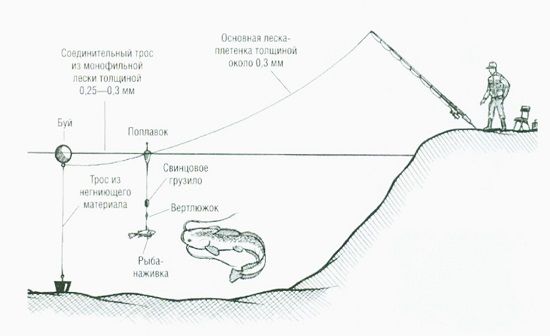
This type of equipment requires the use of a reliable sinker so that large live bait does not drag the entire equipment with it. To catch a heavy catfish, the weight of the fish can reach 300 g.
We take a rod 3 m long, casting weight – 100-400 g.
The reel must match the selected tackle. Type - multiplier, inertia-free with a large spool so that it can freely fit, for example, 200 m with a diameter of 0.4 mm.
It is recommended to have a baitrunner - a lever, the lifting of which allows the fishing line to unwind freely from the reel. An alternative is a high-quality friction brake.
Preparation and installation of gear for catfish
Fans of catfish fishing are well aware of how unpredictable such an activity can be. Fighting giant prey requires good preparation and effort. And before going to the reservoir, the gear for catfish is selected with special care.
Choosing gear depending on the type of fishing
Being the largest inhabitant of freshwater bodies, catfish can offer strong resistance when fishing. To get it out of the water onto the shore, you need to use strong tackle.
It must withstand not only the large weight of the predator, but also suppress its jerks. The choice of fishing tool depends on the type of fishing.
Gear requirements
When going to the store to buy tackle for catfish, you should choose reliable designs that are ready to cope with any load. There are also a number of requirements that need to be taken into account:
- Rod. It uses powerful fishing rods, adapted for a long fight with a large predator. The best option is a fiberglass model, about 3 m long (if you use longer models, this will complicate the process of controlling the jerks of the fish in the last minutes of fishing). The test load should be 100-300 g for live baits and 100-150 g for artificial products.
- Coil. For catfish fishing, use a reel with a 200 m spool made of durable materials. Experts recommend buying inertia-free models for sea fishing or multipliers. Metal carp reels are suitable for the average catfish.
- Hooks. You can catch catfish with both homemade and factory hooks. The main thing is that they are made of high quality steel. The type of hooks is determined by the size and weight of the bait. So for a large bait, use a large product numbered 8-10, and for meat shells, worms and light baits take a smaller hook (No. 5-6).
- Network. Catfish fishing is carried out using a braided cord with a thickness of 0.35−0.7 mm. Unlike classic fishing line, braided line can withstand loads of up to 30-60 kg. When catching small catfish, the use of fishing line is allowed. Its diameter should be at least 0.6−0.7 mm.
- Leash. It is advisable to use Kevlar models, which have increased flexibility and resistance to strong jerks. The breaking load indicator reaches 50−150 kg. Products made from this material bind well, are not afraid of stretching and are protected from being bitten. A good alternative for a Kevlar leash is a thick fishing line, at least 1 mm thick.
From the shore
You can catch catfish from the shore using either spinning or bottom gear. The second option is considered the most convenient, but does not belong to the category of sports. It involves installing a stationary structure on the shore and waiting for a bite.
When preparing equipment, it is necessary to take into account the specifics and location of fishing. If fishing is carried out in places with an abundance of snags, stumps and other bottom debris, it is better to use a strong fishing line with a reserve.
Single models with a long shank are used as a hook, since they are less likely to get caught on snags. The diameter of the fishing line for donkey is at least 0.6 mm. The optimal weight of the sinker is 200-300 g, and the shape is oval with a longitudinal hole.
The bottom tackle is equipped with a leash 1-1.5 mm long. A good bait for catfish is a live frog. The predator is also interested in the smell of spoiled tripe.
In open water, barbel is caught from early spring until late autumn. Sometimes winter fishing for catfish is allowed, provided that the reservoirs are not covered with ice. But it is difficult to predict how the catfish will behave in winter if its activity decreases greatly during the cold season.
From the boat
The principle of boat fishing is practically no different from shore fishing. At the same time, the presence of a swimming device allows you to change the casting location in the event of a lack of bite.
To attract a trophy, you can use a clever device - “kwok” - catching catfish using this device always brings a good catch. It creates a specific sound that attracts fish from a great distance. The bait used is live bait, frog or crawler.
Spinning tackle
Spinning fishing is considered a difficult activity that involves fighting large prey. To extract a river monster from the water, you need to use powerful, functional and reliable fishing rods with good shock-absorbing properties. When assembling gear for trolling catfish, you should give preference to special models designed for this method of fishing.
Selection of wobblers
One of the most effective baits for catching catfish is a wobbler. Fish are well attracted to both floating and sinking models, and the key requirement is the depth of the product. This property is provided by the manufacturer, but the angler can change the immersion depth of the wobbler himself.
When catching catfish by trolling, you need to consider the following factors:
- Diameter of braided line.
- Distance between boat and bait.
- The speed of the boat.
The bait will be submerged to the maximum depth when using a thin line. Fans of trolling fishing prefer the following models of wobblers: Rapala Super Shad Rap, Mann's Stretch, Halco Sorcerer and Bomber Deep Down Long A.
The listed wobblers for catfish demonstrate good effectiveness due to the wide variety of colors, stable and attractive play, as well as good immersion depth. And according to experienced spinning anglers, a “bomber” wobbler for catfish is the best solution in its price category, allowing you to attract even lazy fish.
Spoons
Every angler's arsenal should include catchable lures for catfish. Particular attention is paid to thick-walled models with large dimensions and heavy weight.
The bait is slowly pulled along the bottom, causing the turbidity to rise, which creates an imitation of the movements of live prey.
Coil selection
If you are interested in how to catch catfish, you need to carefully select a reel. It uses a reinforced product with a spool capacity of up to 3000-5000. At the same time, the predator is caught with both powerful carp reels and models for sea fishing.
For catching catfish by trolling, both power multipliers and inertia-free structures are allowed.
Rod
An important element of equipment for catfish is the fishing rod. It should be as durable as possible, able to withstand strong and aggressive jerks. The optimal length is 2.7−3 m, and the test is 20−60 g. Preference is given to forms with a fast action.
Hooks
To catch catfish with live bait or artificial bait, you must use high-quality hooks. They must be made of durable materials, have sufficient size and degree of sharpening. You can use both store-bought and homemade hooks for catfish (The size of the hooks is determined by the size of the expected catch).
If you expect to catch 5-kilogram specimens, you can get by with carp hooks. Larger predators are caught with hooks numbered 5,9, 10 and larger, depending on their weight. You can't skimp on these products.
Installation
At the stage of installation of gear for catching catfish with spoons or live bait, the reel is equipped with a strong fishing cord or fishing line, 200 m long. A load is fixed at the end of the main line, and a leash and hooks are attached at a distance of 50 cm from the load.
Swivels or carabiners are used as fastening elements. Fishermen also advise installing a leash with a forged hook, instead of a single product.
Other types of gear for catfish
In addition to classic gear, homemade structures are used to catch catfish from a boat and shore. Some homemade products are superior to store-bought ones due to their ability to handle any kind of prey.
Equipment with underwater float
For many years, to catch the predator, fishermen used a clever tackle - a donk with an underwater float. Its distinctive feature is the location of the float.
Unlike classic bottom fishing, here this part of the equipment is under water, providing additional play for artificial bait or live bait.
The design is a small cylinder or an elongated ellipse, which can be used both in still water and under strong currents. The underwater float is made of materials with good buoyancy, including:
- Cork.
- Styrofoam.
- Other polymer raw materials.
It is not difficult to install a catfish tackle with an underwater float. All materials and available tools are available in the home workshop, and you do not need to use additional equipment to assemble them.
Changeover
Catching catfish in spring or autumn is carried out using a net. This design is made from a durable cord equipped with one and a half meter leashes with hooks. The tackle is pulled from one bank to the other across the river. There are bottom and top models.
The first option is equipped with an additional weight that ensures fixation of the nozzle at the very bottom. The harnesses are stretched over the water or along the surface of the reservoir so that the hooks and bait are at a distance of 30-40 cm from the water.
Spear fishing
Today, such a direction as underwater hunting is actively developing. The use of a harpoon allows you to catch a trophy barbel that is large in size and weight.
Catfish activity increases in mid-May, when the water temperature rises to +17...+18°C. During this period, predators begin to spawn, but there is an official ban on fishing in the country. You can start hunting only after spawning has completed, somewhere in early summer.
With the arrival of summer heat, the river water becomes cloudy, so finding prey in it is problematic. Experienced spearfishers consider autumn to be the best time to dive. Autumn cold improves visibility underwater, providing better conditions for your next dive.
In the fall, hunting river catfish is much easier and more effective. In addition, at this time the largest representatives of the species emerge from the pits, which makes the hunt especially exciting.
Often an underwater gun is used to catch catfish in winter. This is possible under favorable weather conditions, when reservoirs remain open from ice.
Pulse fishing rod
There are less common fishing methods that are prohibited by law, but are still used by unscrupulous fishermen. Among them is the use of an impulse fishing rod. The tackle generates an electrical impulse that affects defenseless fish, killing it instantly.
In addition to large individuals, fry and young fish float to the surface. Many of them die, but the rest are damaged and can no longer reproduce.
What homemade tackle is easiest to assemble with your own hands?
It’s not difficult to assemble homemade gear for fishing for catfish. But some options have an intricate design and require installation skills. The rest are quite simple to make, so even a beginner can make them.
Among them is the classic donka. To create the tackle you will need a strong cord, a large hook and a heavy sinker. The latter equipment is cast independently from lead or purchased at a fishing store.
Particular emphasis is placed on the quality of the fishing line. For a homemade product, use a twisted or braided cord that can withstand loads of up to 50-60 kg. The optimal fishing line length is 50−100 m.
Single but large models made of 5-6 mm strong wire are used as hooks.
It’s not difficult to set up catfish supplies with your own hands. It is enough to prepare the necessary equipment elements and connect them one by one. A good homemade product allows you to catch catfish in winter and summer with equal efficiency.
Best lures
When choosing bait for a hook, you need to remember the myopia of the river monster. Possessing poor eyesight, the catfish demonstrates a good sense of smell, hearing and sensitivity of the sides, with which it detects any fluctuations in the water column.
For fishing, you should use moving baits with an intense smell.
Medvedka
Experienced fishermen have been catching barbel with a mole cricket for a long time. The attachment has some advantages that make it better than other options.
Firstly, it is interesting only for catfish, and causes a strong appetite in the predator. Secondly, unlike the crawler, it can stay in the water at any time of the day or night. The river giant responds well to both living and dead mole crickets.
The bait is put on face down. To do this, you need to take it by the body and pierce it with a hook in the neck area with the sting down. Given the aggressive behavior of mole crickets, they cannot be stored in the same container. Each animal is placed in a separate jar of grass and transferred to the refrigerator.
Liver
One of the most effective baits for catfish is chicken liver. However, it does not hold well on the hook, so it attracts fish for a short time. To improve the fixation of the liver, it can be frozen in the refrigerator. The melted product can be placed in a nylon stocking so that it does not crumble in the water.
Soap
In Soviet times, catfish were caught using laundry soap. Then it was created on the basis of animal components without adding aromatic additives.
The composition of modern soap has changed, so the chances of catching a barbel on a piece of such a substance are minimal. In some conditions, the bait justifies itself, provoking the catfish to bite.
Frog
A frog is a classic bait for any catfish fishing. Bait can be found in any pond, but it cannot live long without air underwater. Therefore, before going fishing, it is better to stock up on a large number of frogs in order to change them as activity decreases.
Catching catfish with a donk, feeder, spinning rod, “kwok” and other mentioned gear is always accompanied by unforgettable emotions and a surge of adrenaline.
You never know what kind of monster might be on the hook or how long it will take to fight it, so the time and effort spent is justified by the trophy catch.
Source: https://ribaku.info/snasti/na-soma-2
Effective baits
Experienced fishermen have noticed that if there is no carp or carp biting for several days, then you should try your luck in catching a catfish. Because, hunting for food, the predator scares away peaceful fish.
It is worth paying attention to the quality of the bait in order to lure the long-awaited trophy to the desired area of the reservoir. Chopped, whole worms or chicken giblets will do. They are mixed with clay and soil and formed into balls. The cast is performed within the radius of the fishing point.
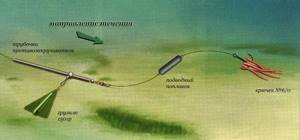
It should be borne in mind that the future catch depends on the size of the bait. If you want to catch not a small catfish, but a weighty beauty, the bait must be appropriate.
The range of favorite catfish dishes is quite large.
The most popular options include:
- bunches of leeches, crawlings;
- pieces of fish;
- frogs;
- chicken offal (liver, heart, intestines);
- fry of roach, crucian carp, sebel;
- crayfish meat;
- caterpillars;
- mussels;
- locusts, mole crickets.
Fishing for catfish from the shore
If you are not afraid of experiments, then you should try to bait:
- furry crab meat;
- cuttlefish rings.
The latter works well when installing float equipment. The unusual smell and appearance of the rings are interesting for catfish.
Baits
Usually the most popular options for catching catfish are used - a bunch of crawlers or leeches, dead fish, pieces of fish, frogs or live bait. If targeted fishing for this particular river giant is carried out, then the amount of bait on the hook and the size of the live bait must match. Because otherwise, instead of the purpose of fishing, smaller predators like pike or pike perch will regularly bother you, and when using worms, even bream. Most anglers will only be happy with such a bycatch, but when hunting for a trophy, baits are needed as large as possible in order to cut off bites from smaller fish.
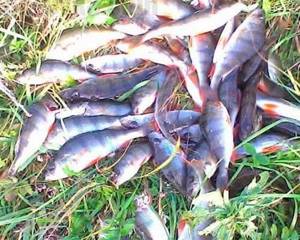
Choosing a place and time
This predator is a heat-loving individual, although it loves to live in the depths. Found in quiet deep-water rivers and large ponds.
Loves the following areas of the reservoir:
- with large vegetation in the form of reeds and water lilies;
- under snags;
- deep holes, whirlpools;
- debris of branches.
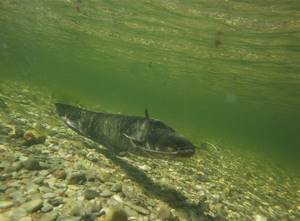
Recommended time for fishing with a donk with an underwater float is late evening, night. That's when the catfish goes hunting.
At night, the predator can be caught even from the shore in shallow water, since frogs live there - one of its favorite types of food.
July and August are considered the catching months.
In cool weather, it is better to fish from a boat, throwing tackle to the entrance of holes or under snags.
Fishing for catfish
Fishing a catfish out of a river is considered one of the most difficult tasks in catching a freshwater giant. After all, this process requires special care and a lot of patience. Once a catfish is hooked, you should not immediately pull it ashore. In such a situation would be much better to tire the fish - it will be much easier for you to cope with a tired catfish. And if suddenly a caught catfish decides to lie low, don’t despair, because you can easily scare it and force it to get out. To do this, it will be enough to simply knock on a nearby snag - catfish are very afraid of knocking and practically fall into panic.
To fish for catfish, you should wear canvas gloves in advance, which will help avoid unnecessary cuts and injuries. After all, catfish are not easy prey!
The first sign of fish fatigue will be the catfish turning its belly up. It is at this moment that you can seriously take hold of the fish and slowly drag it to the shore. In shallow water, catfish have almost no chance to resist. And here it will be very convenient for you to grab the giant by the gills and bring him to land.
Making an underwater float with your own hands
The creation process is not complicated, so even beginners can handle it.
As a material, you can take a piece of foam rubber, light wood, or cork. The latter is the most convenient to take, since such a workpiece does not need to be turned and shaped. You will have to tinker with even dense polystyrene foam.
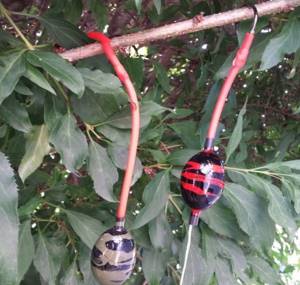
Subject to painstaking work, a homemade float is not inferior in appearance and catchability to store-bought counterparts.
Let's look at an example of creating a float from a cork plug.
Procedure:
- If necessary, give the cork a streamlined shape. We do this with sandpaper.
- We take a used firefly or a small-diameter plastic tube (from Chupa Chups).
- We drill a hole through the plug, the diameter corresponding to the tube, that is, the future antenna.
- We thread a firefly through it. An ideal option when it goes in tight.
- We stretch the leash through the workpiece and install the hook.
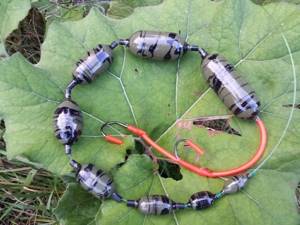
Depending on the float capacity you want to achieve, the cork plugs can be divided into halves or several pieces can be connected at the same time.
Finally, the finished product along with the antenna is painted with a bright-colored varnish and a waterproof marker.
Creation time – no more than 15 minutes. Therefore, in order to save money, you can make underwater floats for catfish at home, without making much effort.
Tackle design features
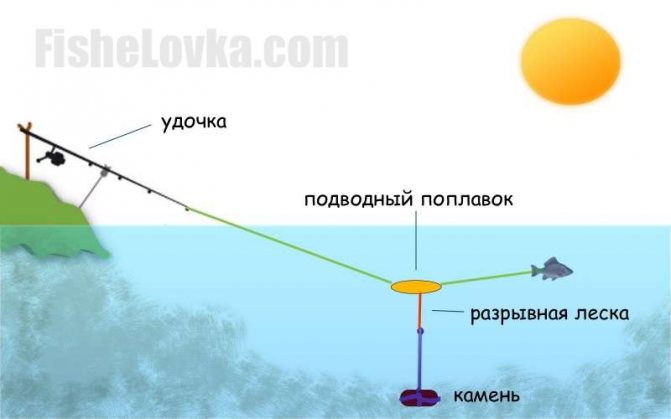
Photo 1. Equipment diagram.
As the name of this rig suggests, the main feature is the underwater float. It is this that provides additional mobility to the bait or live bait (and does not serve to display a bite), which has a positive effect on their attractiveness for the main purpose of fishing. An underwater float for catfish looks like a cylinder or an elongated ellipse (this shape makes it suitable for use both in currents and in still water), and is made of materials that have positive buoyancy. Often this is cork, foam plastic or other polymer materials, which makes it possible to independently produce such gear. Mountings for such floats are used both with a sliding sinker and blind ones.
There are fishermen who prefer to use rather heavy stones (from 2 kilograms or more) instead of a weight. This ensures that the gear is self-hooking, but such equipment will have to be transported to the fishing site by boat. The stone is tied with a relatively thin rope made of natural materials and attached to the equipment with a thin breaking line, which breaks when a catfish bites, and such a heavy sinker does not interfere with the process of fishing for the trophy. This option is used infrequently, since the use of such a load is quite inconvenient and requires the fisherman to have a swimming device.
Important! The sinker can be either sliding or tightly fixed, but the float should not slide along the equipment.
Fishing tactics
Fishermen advise using an installation method, thanks to which hooking can be done almost immediately. Its essence lies in the fact that live bait is attached to a tackle with a standard hook and tee.
We pierce the upper and lower lips of the fish with a regular one, and we hook a triple one in the area of the caudal fin. We use a steel wire leash to prevent other predators from biting it ahead of time. Next, the standard float installation of the equipment is carried out.
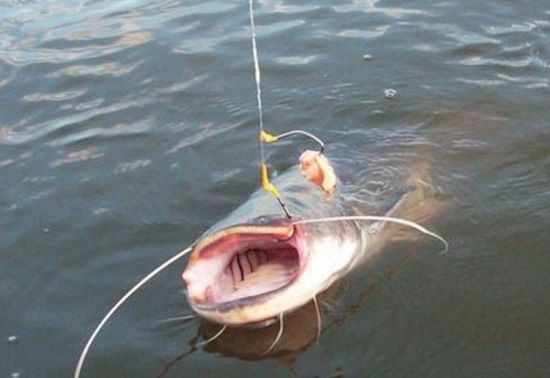
The catfish is such a predator that you try to catch it alone. Carrying out high-quality fishing for a heavy predator yourself will cost the loss of a trophy or equipment. Therefore, it is better to always take a partner with you.
If you have a fish on your hook, then the main task is to exhaust it and drag it ashore without strength. In the case when the catfish tries to hide at the bottom in the snags, try knocking with a stick. This fish is shy and will look for a way back out.
For fishing, a landing net or hook and thick construction gloves will be useful. The latter are a guarantee of the integrity of hands and fingers.
It is believed that you need to pull a catfish ashore by its mouth. Place your thumb in the mouth and grab the outside of the lower lip with the rest. You should not do this with bare hands - there is a high risk of cutting yourself on sharp teeth or driving a hook into your finger.
You will find other interesting nuances of catching catfish on an underwater float in the video at the bottom of the article.
Places suitable for catching catfish
When choosing a place in which to catch catfish on a donkey from the shore, each fisherman must have a clear idea of what the size of his catch will be. Swimming areas and small canals offer excellent fishing for small catfish.
Quite often in such places it is possible to meet individuals whose mass is approximately one kilogram. The main advantage of this type of fishing is that it does not require any special conditions.
Often, fishermen catch small catfish completely by accident. This happens when large crucian carp are caught in canals and dung worms are used as bait. Fishing using a donkey for catfish from the shore is especially convenient in a small channel.
This large and medium-sized fish can most often be found in places with deep holes, as well as in large rivers (in their ruts), the flow of which has an average speed. However, it is worth noting that the rarest specimens - catfish trophies - can only be caught in a large and deep reservoir. Such individuals are found in large numbers near gravity dams, as well as dams of large rivers.
Large catfish live where underwater snags and stones are collected in large quantities. From time to time they completely bury themselves in the bottom mud. On your very first visit to the place where you want to start catching catfish, first of all you need to talk with local fishermen who are familiar with the topography and structure of the bottom.
Local fishermen who use a primitive wooden reel and rough construction line for fishing usually have the largest catch, unlike those who are not familiar with the area and just came to try their luck.
In Russia, in the summer season (from the beginning of July to September), large catfish are excellently caught in the central and southern regions, since during this period the water warms up very well. October is considered the very last month of the fishing season. Catfish hunt mainly near the exit from their holes, and only occasionally swim to a warm and shallow stretch.
Donka for catfish is an ideal option for fishing in the evening or at night. The best time of day for fishermen who want to catch larger catfish begins in the evening at ten o'clock and ends the next morning at five. Small individuals of catfish can be caught at absolutely any time of the day, but they are especially active only at night.
Advantages of choice
According to fishermen, such equipment provides the following advantages:
- Preventing frequent overlapping of the fishing line and tangling of the gear.
- Natural behavior of live bait in the water due to the long leash length.
- Factory models of underwater floats have built-in noise capsules, the sound of which can lure a predator from a great distance.
- The ease of assembly, installation and availability of materials allows you to make them yourself in unlimited quantities.
- Baits like leeches and crawlers will be much more attractive to catfish with this type of equipment, especially in a body of water with a current.
Using bottom gear with an underwater float provides greater chances of catching than with standard methods. The rest depends on the right place, time, bait and, most importantly, the skills and patience of the fisherman.
Choosing gear depending on the type of fishing
Being the largest inhabitant of freshwater bodies, catfish can offer strong resistance when fishing. To get it out of the water onto the shore, you need to use strong tackle.
It must withstand not only the large weight of the predator, but also suppress its jerks. The choice of fishing tool depends on the type of fishing.
Gear requirements
When going to the store to buy tackle for catfish, you should choose reliable designs that are ready to cope with any load. There are also a number of requirements that need to be taken into account:
- Rod. It uses powerful fishing rods, adapted for a long fight with a large predator. The best option is a fiberglass model, about 3 m long (if you use longer models, this will complicate the process of controlling the jerks of the fish in the last minutes of fishing). The test load should be 100-300 g for live baits and 100-150 g for artificial products.
- Coil. For catfish fishing, use a reel with a 200 m spool made of durable materials. Experts recommend buying inertia-free models for sea fishing or multipliers. Metal carp reels are suitable for the average catfish.
- Hooks. You can catch catfish with both homemade and factory hooks. The main thing is that they are made of high quality steel. The type of hooks is determined by the size and weight of the bait. So for a large bait, use a large product numbered 8-10, and for meat shells, worms and light baits take a smaller hook (No. 5-6).
- Network. Catfish fishing is carried out using a braided cord with a thickness of 0.35−0.7 mm. Unlike classic fishing line, braided line can withstand loads of up to 30-60 kg. When catching small catfish, the use of fishing line is allowed. Its diameter should be at least 0.6−0.7 mm.
- Leash. It is advisable to use Kevlar models, which have increased flexibility and resistance to strong jerks. The breaking load indicator reaches 50−150 kg. Products made from this material bind well, are not afraid of stretching and are protected from being bitten. A good alternative for a Kevlar leash is a thick fishing line, at least 1 mm thick.
From the shore
You can catch catfish from the shore using either spinning or bottom gear. The second option is considered the most convenient, but does not belong to the category of sports. It involves installing a stationary structure on the shore and waiting for a bite.
When preparing equipment, it is necessary to take into account the specifics and location of fishing. If fishing is carried out in places with an abundance of snags, stumps and other bottom debris, it is better to use a strong fishing line with a reserve.
Single models with a long shank are used as a hook, since they are less likely to get caught on snags. The diameter of the fishing line for donkey is at least 0.6 mm. The optimal weight of the sinker is 200-300 g, and the shape is oval with a longitudinal hole.
The bottom tackle is equipped with a leash 1-1.5 mm long. A good bait for catfish is a live frog. The predator is also interested in the smell of spoiled tripe.
In open water, barbel is caught from early spring until late autumn. Sometimes winter fishing for catfish is allowed, provided that the reservoirs are not covered with ice. But it is difficult to predict how the catfish will behave in winter if its activity decreases greatly during the cold season.
From the boat
The principle of boat fishing is practically no different from shore fishing. At the same time, the presence of a swimming device allows you to change the casting location in the event of a lack of bite.
To attract a trophy, you can use a clever device - “kwok” - catching catfish using this device always brings a good catch. It creates a specific sound that attracts fish from a great distance. The bait used is live bait, frog or crawler.
Bottom equipment and underwater float
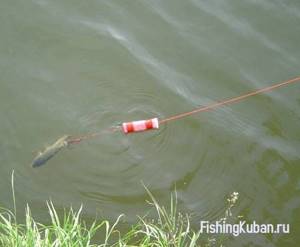
In this article we will talk about a relatively little-known device that guarantees the correct presentation of the bait in conditions of a “difficult” bottom - heavy siltation, snags and submerged trees, tall dense algae, rocky areas with deep crevices, sharp ridges of pearl barley protruding above the sand. After all, they are the favorite place for fish and at the same time a place where fishermen are left without equipment.
To avoid losing the hook somewhere in the mud, a crack or between stones, as well as tangling and breaking the leash in algae and snags, the equipment needs to be slightly raised above the bottom. So much so that, without alarming the fish, make the bait accessible to it. However, you should not forget that the sinker, leash and fishing line remain undisguised, and the bait hanging in the water column does not look as natural as lying on the bottom. The best way is to provide the bait with neutral buoyancy, making it drift near the bottom, almost touching it. This can be achieved using an “underwater float”.
Between the leash and the sliding sinker on the fishing line, a movable float with a more or less streamlined shape is installed. The carrying capacity of the float should exceed the weight of the sinker used by approximately 2.5 times. In other words, it should float up slowly, along with the leader, hook and bait, without displacing the main line lying at the bottom.
The role of such a float can be a piece of cork, foam plastic, or an ordinary float with a broken antenna or keel. Whatever material it is made of, a through channel is drilled in it along the longitudinal axis, through which the fishing line is threaded. The float is fixed on it with a wooden wedge (match or toothpick). It should be painted in neutral colors. In this sense, tree bark or unpainted cork are best.
A properly adjusted underwater float not only lifts the bait above the bottom, but also constantly changes its location by pulling or releasing the fishing line. When the line is pulled up to the stop of the float, the bait lies on the bottom. And when it is released, the float slowly floats up and carries the bait with it. In a similar way, an increase in the efficiency of searching for fish is achieved with sequential fishing of different water horizons, without focusing on catching only bottom-feeding fish species (crucian carp, bream, carp, etc.).
Of particular interest is the use of a bottom float in catching predatory fish. Firstly, the efficiency of “passive” baits (molting crayfish, barley meat, dead fish, shrimp) increases significantly. They are balanced by it to neutral buoyancy, which gives the nozzles some mobility (especially in the current). And a moving bait naturally attracts fish more.
Secondly, when fishing with live bait, a sinking float will give the fish more freedom to move, while at the same time preventing it from hiding in the algae or tangling the tackle. This can be achieved by precisely calibrated release of the fishing line. The absolute length of the leader is the distance from the bait to the float.
The tackle needs to be thrown to the right place, then tighten the line until the float hits the sinker. Then return so much fishing line so that the release exceeds the absolute length of the leash by 10 - 15 cm. As a result of quiet manipulations, the baitfish will move quite freely, and the float will not allow it to sink to the bottom or swim far.
Thirdly, when attacked by a predator, the float, to some extent, “masks” the stretching fishing line and conceals the weight of the sinker. As a result, this increases the number of effective bites, because the predator does not notice the tackle longer and does not throw the bait because of this.
An underwater float is used not only on a simple donk, but also on a feeder. True, it’s hardly worth equipping your gear with it without the need. Where the nature of the bottom allows you to fish with conventional equipment, a sinking float is only a hindrance that does not allow you to disguise the fishing line. So before using it, you need to carefully study the nature and topography of the bottom.
The process of fishing with a water-filled float
In principle, there are no very big differences between conventional fishing and fishing with water-filled floats, except for the most significant: the ball will need to be filled with water before casting. To do this, the side plugs are opened, the tackle is immersed deep into the reservoir and filled with liquid to the required level. At the end of the procedure, all you have to do is tightly close the holes in the case with rubber plugs.
The weight of the equipment and, naturally, the casting distance will depend on the amount of water poured. The moment the float touches the surface of the water, a loud slap will be heard. The fish will blur from the noise (in some cases, vice versa), but after some time it will swim back to the fishing spot.
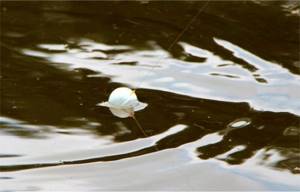
The larger the volume of liquid inside the vessel, the deeper the float will plunge into the water. Another advantage of the large mass is the reduction of windage when casting. This means that in a strong wind the ball will fly in the right direction and will not be blown away by the wind, which is a tangible advantage compared to conventional tackle.
When fishing on rivers, the float will be carried down by the current, and the fisherman will only need to gradually release the line on the reel. On lakes you can sometimes move the bait while playing with the fishing line in different directions.
Although the “bulb” may seem rough, this is not entirely true - the tackle signals a bite very well. The principle of its operation: the fish touches the leash, the movement is transmitted upward, and circles begin to disperse through the water. By their size, an experienced fisherman can recognize whether the fish is interested in the bait, and even with a high probability is able to determine the weight of the fish.
Bait for catfish on bottom gear
When choosing bait for catching catfish, first of all take into account the myopia of this fish. Due to its poor eyesight, the river giant has an exceptional sense of smell, hearing and sensitive sides, thanks to which it is able to sense even minimal fluctuations in water over long distances. Therefore, experts advise choosing baits that move or have a strong odor.
And here's what you need to know: Increasing the efficiency of feeder fishing - Fishing with a feeder
Small individuals can be caught using dung worms or chafer larvae as bait. The most successful solution would be to catch catfish with live bait:
- pike,
- pike perch,
- crucian carp,
- perch,
- saberfish,
- rudd,
- herring.
Many anglers also recommend baiting with a frog. In addition, crayfish meat performed well as bait. And some fishermen quite successfully use locusts and mole crickets. You shouldn’t discount such common baits as worms, caterpillars, mussels, and pieces of meat. And this list can be continued for an extremely long time, but do not forget about other nuances regarding attachments.
It is extremely important that the dimensions of the chosen bait correspond to the dimensions of the expected catch. The larger the bait you put on your hook, the better your chances of catching a really big catfish.
How to attach a water ball to a fishing line
In principle, it is very simple to mount the tackle: we tie the main fishing line to one eye in any way. It is still better to use a carabiner for these purposes, but first you need to check whether the tackle is threaded through the loop. The option with a snap hook is perfect when you plan to fish different bottom layers. Thus, you can quickly replace this model of float equipment with a conventional one (and vice versa).
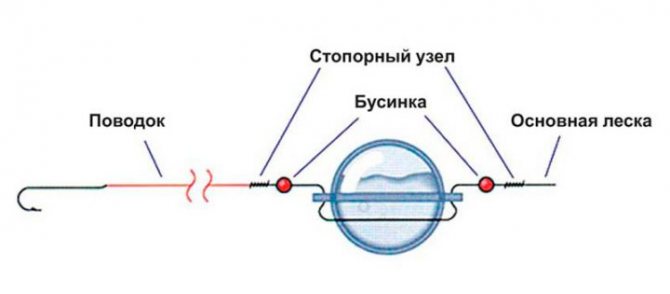
A leash is attached to the other eye of the float using a “loop-to-loop” method. The thickness of the leader line should be small: from 0.14-0.18, because such tackle is mainly used for catching small-sized fish. Depending on the size of the fish, select the length of the leashes from 0.5 to 1.5 m.
In the area of the hooks, the tackle is loaded with several 0.2 gram lead pellets. This way you can distribute the weights more evenly along the entire length of the leash. Hooks can be used in a variety of models.
General requirements for gear
Since when fishing for catfish, a large load will be placed on the fishing rod, the fishing rod must be very strong and durable, otherwise it may simply not withstand the weight of a large individual.
- donka;
- float rod with live bait;
- zherlitsy.
If you have certain skills, you can also catch catfish by nodding and casting. But in any case, you need to select fishing gear taking into account the type of reservoir in which you will be fishing, from a boat or from the shore, and what the weather will be like that day.
If fishing is carried out from the shore, experienced fishermen advise beginners to use a plug rod, and it is advisable that its length does not exceed 3 m. Such a fishing rod can be classified as universal, since it is also suitable for fishing from a boat.
Many fishermen make a common mistake - they purchase longer fishing rods, but such gear is quite difficult to use and can make the fishing process less comfortable.
And here's what you need to know: Catching crucian carp on a crust of bread video
The reel also plays an important role; this device must be of truly high quality and made only from durable parts. You can use either a regular meat grinder or a multiplier, the main thing is that the product has a metal spool on which you can wind at least 200 m of braid.
Experts warn that it is not advisable to use regular monofilament thread, since it can simply burst when jerked. Catfish are usually caught on a fishing rod with thick braid (about 0.6 mm), which can withstand a break of up to 60 kg.
